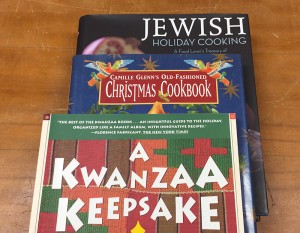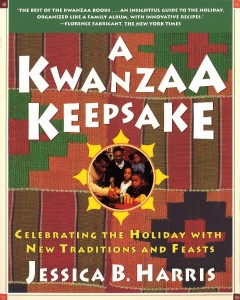While many of the books at Hoole Library are old and/or rare, some are simply part of a special collection of materials which may include very recent publications. I like to think of them as rare books in training.
One kind of specialized resource we have a lot of is cookbooks. Soon, we’ll be mounting an exhibit with items from the Lupton Collection of African-American Cookbooks and from a donation made by Rev. Wylheme Ragland. However, we have cookbooks in just about every book collection at Hoole, especially the Wade Hall collection, which tends to focus on Southern foodways.
Today, we look at three of these cookbooks, reflecting three December holidays: Hanukkah, Christmas, and Kwanzaa.
Hanukkah
Jayne Cohen’s Jewish Holiday Cooking
Hanukkah is the annual celebration of the successful revolt of the Maccabees over Seleucid King Antiochus IV Epiphanes in the 2nd century B.C.E. The lighting of the menorah recalls the miracle of a Temple lamp which stayed alight for eight days, even though there was only enough oil for one. According to Cohen, this commemoration “resonates powerfully in the dead of winter, reflecting the triumph of faith over faithlessness and hope over despair” (253).
The emphasis on oil translates to a lot of fried foods, something not usually possible for major Jewish festivals and observances, for which meals must be prepared beforehand. Unsurprisingly, the Hanukkah section is chock full of recipes for latkes. Here are just a few examples:
- Creamy Potato-Onion Latkes
- Crispy Shallot Latkes with Sugar Dusting
- New Mexican Sweet Potato Latkes with Lime-Sour Cream Sauce
- Mediterranean Chickpea Latkes
- Herbed Spinach Latkes
- Walnut-Cherry-Cheese Latkes
One hint from Cohen about latke batter: Cold batter will cool the oil and lead to soggy latkes. Let your batter get up to room temperature before frying it.
Hanukkah began this year at sundown on December 6, and it will end at nightfall on December 14.
Christmas
Camille Glenn’s Old Fashioned Christmas Cookbook
Christmas commemorates the birth of the Christian savior, Jesus, at the dawn of the first century C.E. Glenn points out that the celebration was designed to hook into the symbology of existing midwinter festivals like the solstice and Saturnalia, which celebrated how the long, dark nights of winter would be soon turning to longer days and more sun (xiv).
Many Christmas traditions are essentially from 19th century England or Germany, such as putting up a lighted Christmas tree. Glenn argues that these traditions especially took hold in the South, which was less Puritan and blessed with abundant resources during its milder winters. Her cookbook reflects her Southern upbringing. One of her Christmas Eve menus finds the usual flavors of the season (harvest spices and autumn fruits) alongside a Southern staple: country ham!
- Mulled Red Wine
- Country Ham Baked in Cider
- Spiced Pear and Cranberry Relish
- Baked Brown Rice with Almonds or Pine Nuts
- Kentucky Bourbon Pie
- Best-Ever Pumpkin Pie
Christmas is always celebrated on December 25, which this year is a Friday.
Kwanzaa
Jessica B. Harris’s A Kwanzaa Keepsake
Kwanzaa is a unique holiday, inaugurated in the 1960s by African Americans who wanted to find a celebration that spoke to their cultural background. They turned, then, to Africa, bringing together elements from various harvest festivals. Kwanza is a Swahili word, meaning “first.” According to Harris, the added second “a” denotes the African American version of the word (13).
Kwanzaa is a time of self-examination, but also of coming together with family and friends. Each day is devoted to one of seven principles: Unity, Self-Determination, Collective Work and Responsibility, Cooperative Economics, Purpose, Creativity, and Faith. Kwanzaa traditions are various, so there is no one traditional menu. Harris, for her part, always chooses food that reflects the influence of Africa on American cuisine. Her proposed menu for the sixth night is complex and looks delightful:
- Pickled Black-Eyed Peas
- Biokosso [a fish dish]
- Turkey with Heritage Stuffing
- Stewed Okra
- Baked Tomatoes
- Plain White Rice
- Herbed Cornbread
- Spicy Cranberry Chutney
- Killer Pecan Pie with Molasses Whipped Cream
Kwanzaa always begins on December 26, which this year is a Saturday, and ends on January 1.




